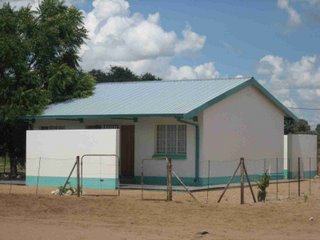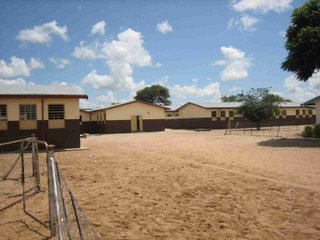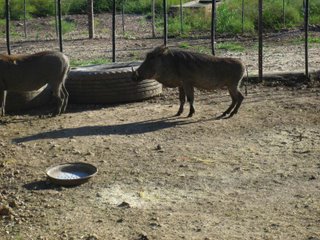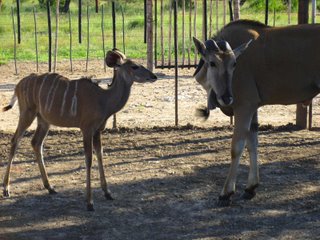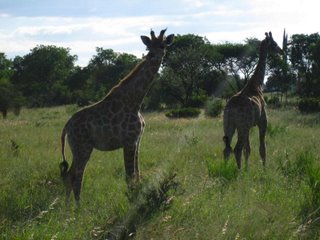I generally teach 4-5 classes a day – I am responsible for only two promotional classes, namely Maths and English for grade 6 which has 51 learners. Beyond the sheer size there is a remarkably different range of competencies and ages. I have 9 year-olds as well as 14 year-olds in the same overcrowded class. So far I have been pretty unhappy with my English classes, both because of my inability to teach them much and the difficulty of teaching kids for 40 minutes in a language that no one speaks outside the classroom. Not only that but according to the syllabus we’re supposed to focus on developing conversational skills not necessarily grammar rules, but when you have 51 kids it’s tough to turn it over to have them talk among themselves.
Maths is better and a lot easier to teach. I think we’ve made some strides this term but I still have problems with learners making mistakes that are from not concentrating on what they are doing. There is also a pronounced tendency to simply write a number without actually thinking about the problem just to have something to show. I check homework everyday but beyond taking about ten minutes during which I have the kids work on a problem or some exercise from the book I see some learners whose answers are completely wrong. There is also a lot of focus on copying by rote but that’s where the work stops. Learners are not used to having to think for themselves, I don’t know how to develop their creativity, it’s startling that after I explain something like making a picture where I want them to show what is important to them and giving them examples of different things they could draw I get exact copies of what is important to them, including many well-copied pictures with the state of North Carolina and the Peace Corps logo.
I choose to focus on my better learners who are definitely getting something out of my classes. I approach the challenge like a field doctor approaches triage – there are some cases that I cannot really deal with in my class, if the learners are causing a problem and do not want to learn there is little I can do but try to minimize their disturbance by sending them out of class or to talk to the principal. The learners still don’t really take me seriously because I don’t practice corporal punishment or even pinch them. I’ve realized that when I give them guilt trips about doing their homework it’s mostly for my benefit.
I have to fill in for Religious and Moral education for grades 5, 6, and 7. I also do Basic Information Science for grades 6 and 7. Those classes are generally used by teachers to mark exams or are literally free time for the kids. Although there is a syllabus it isn’t taken seriously as there’s no exam. I have been using them variously. Because I only see the grade 5 learners once a week I am still stared at like an alien and the kids have only one year of English so it’s pretty hard to try and teach much of anything. I have them type on the computers, play card games, do word searches and other puzzles I come up with. For the grade 6 class I usually will have them work on whatever homework I’ve given them and then help them personally, something I can’t do during a normal class. The grade 7 I still have yet to come up with a good way of dealing with.
After Grade 7 BIS becomes Life Skills which I taught during Model School. Life Skills is a holdover from South African rule and includes topics like personal hygiene, health, sexual development and other classes that we don’t really treat in a regular manner in the US. I think it’s actually a great class and it’s too bad that we don’t have it here at Otjituuo. I think that these personal issues are left for the Matrons to deal with and they’re too overwhelmed by the kids to really do the kind of parenting that the kids need. I’m not sure if you understand that these are kids who see their parents 2-3 months a year, most are the sons and daughters of workers on commercial farms spread out across Otjozondjupa region. Because they don’t have transportation they walk to these farms which might be as far away as 20km. Many are dropped off at school by the Boer farmers who will drive in with 20 or so kids from a farm. Many of the boers are responsible for paying the meager school fees that Otjituuo charges (about US$13 a year). The idea of parent involvement is unheard of here in Otjituuo, which presents a problem as far as discipline. What discipline there is is corporal even though it’s outlawed – the parents just want the staff to beat the kids but I’m still wary of that even if there are times when I lose it with my learners. What this lack of influence does do for the kids is create a self-reliance and unique maturity, like these kids are able to fend for themselves when they need to travel long distances, even at very young ages. There are two Owambo girls in my Grade 6 class who travel by hiking to Oshakati in the far north. The school situation there is even worse and so these girls come to Otjituuo where they don’t speak the same language and have to travel 5 hours to get home. The principal will take them as far as the gas station in Grootfontein and then they’re on their own. In terms of the US that’s like dropping two eleven-year-old girls at a Greyhound bus terminal in Los Angeles and them traveling to San Francisco. But it works. They are also able to watch over other even younger kids. I don’t many parents would entrust a 1 year old to a 9-year-old babysitter but I see that all the time here.
In my off periods I usually make copies for other classes or write emails. Although the school has internet, the NGO that runs it, a Finnish organization called SchoolNet, is also used by 300 or so other schools across Namibia and the slowdown in bandwidth is definitely noticibale as the day goes on. By 11Am it’s barely worth trying to login to Gmail, even without images because it is so slow or the connection just goes out while you are trying to load a new page. I don’t know how many times I have lost entire emails or blog postings. It can be very very frustrating. School is over at 1PM, after 8 periods, except on Fridays when we only have 7. In the afternoons I generally make myself lunch which consists of a tuna fish or PB&J sandwich or an omelette. I think I neglected to mention that my breakfast consists of muesli and yogurt as well as a huge cup of coffee that I nurse throughout the day. In the afternoons I will read and prepare lessons or mark. I also open the computer room to my best learners a few days a week, first going over their math or English homework with them. There are four Pentium II IBM Aptiva machines that were donated by the SanLam insurance company which the previous volunteer loaded with a Super Ninetendo emulator that the kids like to use. To my dismay they play the kind of non-rewarding video games that I favored as a kid and not the ones I try to steer them to (Aladdin and The Lion King). I didn’t use to think that seeing violent movies and video games caused people to mimic the behavior but I can’t help but seeing that the mindless street fighting that they are doing on the screen is influencing the beatings that the kids inflict on each other on the hostel grounds. It’s never anything serious, although I did see a girl with a pretty nasty cut that she told me had been given to her by another girl cutting her. One thing I want to do is get a hold of some childrens movies (animated Disney stuff) to show the kids on weekends when there are movies at the hostel so that they are not just watching some BS action or karate movie.
Around 6:30pm I go running each night on the dirt road to Okakarara, these days I have to double back halfway there as the river that normally is ford-able has completely overwhelmed the road (I am told Otjituuo hasn’t seen rains like this since ’74). I make quite a sight for the children that live in the village, what with my headband and long hair I look like one of the Royal Tenenbaums, and certainly the first white person they’ve ever seen, let alone running. At first being trailed by dozens of village kids running without shoes, shirts or even pants was like some inspirational Nike ad but these days it’s kinda annoying. The kids are obviously totally enjoying every second as it’s the most that’s happened all afternoon, but when I’m trying to give cows, goats, the occasional speeding bakke the slip I’m not in the mood for the little ones yelling “Otjirumbu!” which means “white ghost.” When I clear the village the scenery is definitely picturesque. The road dips about 2km out of the village which is where one of the local farms called Okomunbunde is located. It’s also where people like to smoke weed and go swimming in the river. It’s that time of night when the sun is just going down and it’s actually cool enough to be outside. I have seen some amazing sunsets, the sky is truly different here, I’m not sure if it’s the southern hemisphere or Africa. Sometimes it’s purple, other nights it’s red orange and blue all at once. It’s the aw-shucks moment of the day.
When I get home I will take a shower and cook up something for dinner or eat whatever my counterpart/neighbor Motata Uandara (or to be more accurate his “girl”) has cooked up. In that case it will usually be a piece of goat meat that has been slow cooked with barbeque spice and onions over a hotplate for a couple hours along with pap, aka mealies, aka oruhere, what we call porridge made up of maize meal eaten with sour milk (omaere). There is actually a wide range of milk products ranging from delicious (oshitaku – kinda like a yogurt smoothie) to disgusting (ohambeya, an alcoholic sour milk). If I’m cooking for myself I have been known to vary widely, it is indeed a blessing to have the Peace corps Namibia cook book. So far I’ve made delicious lasagne, an ok Pad Thai, many different stir fries, lots of salad, and even fried chicken on occassoin. My supervisor really likes “American boy” food like hamburgers so I will indulge him but ever since we slaughtered a goat in February I’ve kinda had this aversion to red meat, don’t know why.
At 8:30 it’s time for popcorn and watching Namibia’s national “soapie”
When You Are Mine at Uandara’s. The first time I saw it on NBC (not the American one) I really didn’t get it. But during community-based training in Otjimbingwe it sunk in for me, the genius of it all, and became a nightly tradition. Now a devoted watcher I am generally upset if I can’t make it on a weeknight. Luckily if you miss an episode NBC shows repeats of all the episodes for the week on Sunday morning. To those that still ridicule it, I will say that if you are embarking on a 4 hour hike to Windhoek, I know I instantly have something in common with my seatmate if I say “Oh, that Paloma…”
By 9:00pm I’m getting pretty sleepy. By 10:00 I’m usually asleep or I’ll be regretting it the next day.
